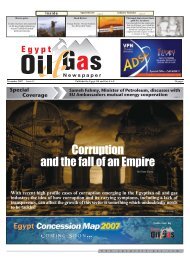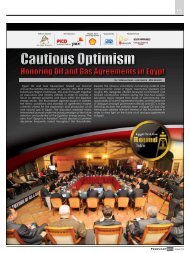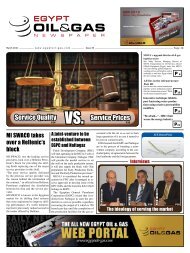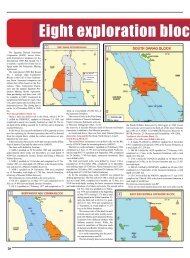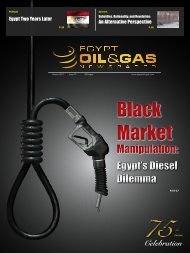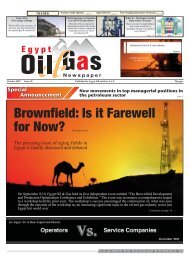EOG Newspaper September 08 Issue - Egypt Oil & Gas
EOG Newspaper September 08 Issue - Egypt Oil & Gas
EOG Newspaper September 08 Issue - Egypt Oil & Gas
Create successful ePaper yourself
Turn your PDF publications into a flip-book with our unique Google optimized e-Paper software.
<strong>September</strong> 20<strong>08</strong> - <strong>Issue</strong> 21<br />
Mazut floats on the Nile!<br />
Large quantities of mazut leaked into the Nile River, last July, after a main oil pipeline of the Helwan<br />
Cement Company (HCC) ruptured, near the districts of Manial and Helwan, resulting in highly polluting<br />
the water and causing three water refineries to suspend operations. Through the involvement<br />
of petroleum service organizations, such as PESCo, the spill was absorbed<br />
By: Yomna Bassiouni<br />
The spill, which covered an area of two<br />
kilometers and was spotted at different locations,<br />
resulted of a leak when the National<br />
Petroleum Pipelines attempted to separate an<br />
unused pipeline from one currently in use, said a senior<br />
member of HCC to Daily News <strong>Egypt</strong>.<br />
Immediately after the leak, authorities interfered in<br />
order to stop the spread of the mazut spot (a heavy low<br />
quality fuel oil used in generating plants and similar<br />
applications) minimize the resulted damages and clean<br />
up the Nile. As a mean to avoid the spill from spreading,<br />
floating barriers, sand walls, iron fences and rice<br />
hay were released to absorb it.<br />
The leaked oil was first channeled to an inland waterway<br />
reserved to absorb rain water. However, when a<br />
water refinery in Kafr El Elw, Helwan poured water into<br />
the waterway, the level of the oil-stained water rose and<br />
overflew in the Nile.<br />
State Minister for Environmental Affairs Maged<br />
George said that the oil spot remained in Helwan and<br />
spread along 2 km. The minister said chemicals were<br />
used to dissolve it, reported Al-Masry Al-Youm.<br />
Omar Abdel-Aziz Mehanna, HCC Chairman clarified<br />
that the company has no responsibly of this leak,<br />
stating that it occurred when Misr Petroleum Pipelines<br />
Company tried to separate an unused pipeline supplying<br />
HCC with mazut from one which is currently in use.<br />
He further added that his company has already filed a<br />
police report about the incident, emphasizing that it has<br />
already been harmed by the consequences of the spill.<br />
“HCC would like to clarify that the pipeline, which<br />
is 600 meters away from the plant, does not belong to the<br />
company and that the company is by no means responsible<br />
of this accident,” stated HCC in a statement released<br />
two days after the incident. “However, as a responsible<br />
corporation, the Helwan Cement plant supported local<br />
authorities in cleaning up the area of Kafr Al-Elw in<br />
Helwan by providing pumps, trucks and fire- fighting<br />
equipment.” The company has denied any responsibility<br />
for the leak.<br />
Shamel Hamdy, the First Undersecretary of the Ministry<br />
of Petroleum declared that water refineries stations<br />
in the areas of Manial and Helwan were not affected and<br />
did not suspend their operations, except for the Kafr El<br />
Elw. Investigations are currently held to determine the<br />
reasons behind this leak, added Hamdy.<br />
PESCo active on the scene<br />
In the contest to control the spread of the mazut<br />
leak, Petro Environmental Services Company (PESCo)<br />
was instructed by the <strong>Egypt</strong>ian General Petroleum Corporation<br />
(EGPC) to assist with the clean-up of the spilt<br />
oil. According to the <strong>Egypt</strong>ian Pipeline Company, the<br />
spill counted for approximately 20 tons of heavy fuel<br />
oil.<br />
The spilt oil shown to PESCo was at the waste water<br />
channel outlet leading into the Nile River. Upon first<br />
inspection the amount of oil at the entrance was approximately<br />
5 meters wide, 20 meters long of varying<br />
thickness.<br />
The polluted areas were divided into three operational<br />
areas,<br />
1. Area (A) Entrance to the Nile,<br />
2. Area (B) Waste water channel on the Nile side of<br />
the road bridge<br />
3. Area (C) Waste water channel on the opposite side<br />
of the road bridge from the Nile<br />
Area (C) was divided into eight<br />
zones, approximately 50 meters each,<br />
the zoning started at the road bridge<br />
(C1) leading away from the road<br />
bridge towards the factories (C8).<br />
Area (A) had some small remaining<br />
patches of oil that were<br />
entrapped in scrap pipes, and old<br />
tanks, upon removal of this debris<br />
the area was quickly cleaned.<br />
The <strong>Egypt</strong>ian Pipeline Company<br />
(EPC) was helpful and all efforts<br />
were made to coordinate as follows:<br />
1. PESCo installed booms to<br />
prevent oil reaching the Nile or<br />
cleaned areas.<br />
2. EPC removed the water grass<br />
and debris using cranes.<br />
3. PESCo removed the oil from<br />
the water using weir skimmers,<br />
rice straw, and sorbent material.<br />
4. EPC removed all waste.<br />
Is river water safe<br />
Technically, the spill was totally<br />
removed from the affected<br />
areas, yet the questions remains; is<br />
the river water safe now According<br />
to officials and authorities, all<br />
water refinery stations are currently<br />
operating and everything is back to<br />
normal. However; some water and<br />
environment experts disagree. Ecologist<br />
Samer El-Mufti told Al-Ahram<br />
Weekly <strong>Newspaper</strong> that the oil spill<br />
would take up to one month or even<br />
more to dissolve, and current analysis<br />
shows very high rates of water<br />
pollution in the affected areas. The<br />
dissolution of the slick depends on<br />
its size and the water cycle, added<br />
El-Mufti. He noted that both the<br />
color and smell of the water have<br />
changed, which is likely to affect<br />
the living organisms in the river. El-<br />
Mufti revealed that the size of the<br />
leak is worrisome, adding that this is<br />
the first of its kind in the River Nile<br />
and that the wind could help spread<br />
the unseen particles of the pollutants<br />
to other areas.<br />
On the other hand, Hussein El-<br />
Atfi, official spokesman for the<br />
Ministry of Irrigation and Water<br />
Resources, gave assurances that the<br />
leakage had not affected the quality<br />
of drinking water. El-Atfi claimed<br />
that the speed of Nile water has broken<br />
down and already flushed away<br />
the oil spill to the Mediterranean. “The quality of Nile<br />
water has shown improvement since the leak,” contended<br />
El-Atfi.<br />
Area (A) Water edge / Pipes and debris<br />
Area (B) had medium to heavy contamination that was further complicated by the presence<br />
of water grass.<br />
Area (B) Flood Water exit from area Nile Side<br />
AREA (C) Zone 1 - Heavy contamination, further complicated by the presence of water<br />
grass and debris.<br />
Area (C1)<br />
AREA (C) Zone 2 - 6 - Heavy contamination, further complicated by the presence of grass<br />
and debris<br />
Area (C2)<br />
Area (C3)<br />
AREA (C) Zone 7- Medium contamination further complicated by debris and grass<br />
AREA (C) Zone 8 - Light Contamination complicated by debris<br />
Area (C 7 - 8)




